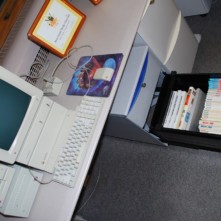Grilling Jason Scott
| July 26th, 2010 12:07 PM by Ken Gagne | Filed under History, People; Comments Off on Grilling Jason Scott |
I heard of BBS: The Documentary before I knew of Jason Scott. I reviewed the film for my first issue as editor of Apple II publication Juiced.GS and thought a good follow-up would be to interview its creator. My first interview with Jason ran in December 2006, though it wasn’t until the inaugural ROFLCon in April 2008 that I got to meet the man himself. I found him colorful, knowledgeable, opinionated — and, most of all, passionate. He’s somebody I found worth keeping tabs on, which is why Computerworld publishes my second interview with him today, the week that his second film, GET LAMP, debuts. Less than half of what Jason and I discussed fit into Computerworld‘s print edition, just like the “PAX cut” of his film shown at KansasFest was only an excerpt of his larger work. Fortunately in the latter case, the final product will be shipped free to all KansasFest 2010 attendees by the end of next month. I can’t wait to review Jason’s latest accomplishment for Juiced.GS.
[This is an] overview of the Apple II Piracy Community of the early to mid 1980’s, presented at the 5th Rubi-Con Conference in Detroit Michigan. Subjects covered include the unique aspects of the Apple II microcomputer architecture and culture, the methods of removing copy protection from software packages of the Apple II, and a very large helping of trivia. To illustrate some aspects of the “crack screens” and other Apple II graphics, an Apple II clone and several programs were provided. Speech delivered on March 29, 2003.
The file is almost exactly 46 minutes in length and discusses the stratification and traditions of early computer users and hackers. What generalizations can we make about Apple II users, and what motivated some of its users to become hackers? What language and practices existed within that subset of users? Jason delivers his speech eloquently while using but not relying on visuals, making his presentation surprisingly effective as an audio-only recording.
Most important to me, this presentation clarifies why Jason made a great keynote speaker at KansasFest 2009. Sure, Apple II users are part of a broader retrocomputing community of which Jason is a member — but his experience with the Apple II is personal and memorable. This small bit of knowledge quickly transformed my perception of him from that of an outsider to that of a peer.
When interviewing Jason about GET LAMP for Computerworld, he told me, “A lot of my stuff was slow-simmering and is now coming to a boil.” I’m glad to see the fruition of more of his work, because I know the Apple II community to which be belongs will benefit.










